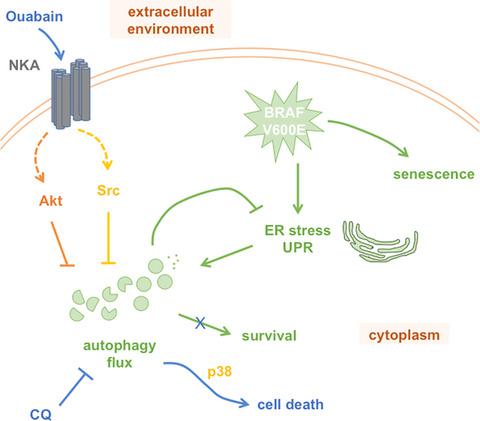当前位置:
X-MOL 学术
›
Aging Cell
›
论文详情
Our official English website, www.x-mol.net, welcomes your
feedback! (Note: you will need to create a separate account there.)
Ouabain and chloroquine trigger senolysis of BRAF-V600E-induced senescent cells by targeting autophagy
Aging Cell ( IF 8.0 ) Pub Date : 2021-08-06 , DOI: 10.1111/acel.13447 Valentin L'Hôte 1 , Régis Courbeyrette 1 , Guillaume Pinna 1 , Jean-Christophe Cintrat 2 , Gwenaëlle Le Pavec 1 , Agnès Delaunay-Moisan 1 , Carl Mann 1 , Jean-Yves Thuret 1
Aging Cell ( IF 8.0 ) Pub Date : 2021-08-06 , DOI: 10.1111/acel.13447 Valentin L'Hôte 1 , Régis Courbeyrette 1 , Guillaume Pinna 1 , Jean-Christophe Cintrat 2 , Gwenaëlle Le Pavec 1 , Agnès Delaunay-Moisan 1 , Carl Mann 1 , Jean-Yves Thuret 1
Affiliation

|
The expression of BRAF-V600E triggers oncogene-induced senescence in normal cells and is implicated in the development of several cancers including melanoma. Here, we report that cardioglycosides such as ouabain are potent senolytics in BRAF senescence. Sensitization by ATP1A1 knockdown and protection by supplemental potassium showed that senolysis by ouabain was mediated by the Na,K-ATPase pump. Both ion transport inhibition and signal transduction result from cardioglycosides binding to Na,K-ATPase. An inhibitor of the pump that does not trigger signaling was not senolytic despite blocking ion transport, demonstrating that signal transduction is required for senolysis. Ouabain triggered the activation of Src, p38, Akt, and Erk in BRAF-senescent cells, and signaling inhibitors prevented cell death. The expression of BRAF-V600E increased ER stress and autophagy in BRAF-senescent cells and sensitized the cell to senolysis by ouabain. Ouabain inhibited autophagy flux, which was restored by signaling inhibitors. Consequently, we identified autophagy inhibitor chloroquine as a novel senolytic in BRAF senescence based on the mode of action of cardioglycosides. Our work underlies the interest of characterizing the mechanisms of senolytics to discover novel compounds and identifies the endoplasmic reticulum stress-autophagy tandem as a new vulnerability in BRAF senescence that can be exploited for the development of further senolytic strategies.
中文翻译:

哇巴因和氯喹通过靶向自噬触发 BRAF-V600E 诱导的衰老细胞的衰老
BRAF-V600E 的表达在正常细胞中触发癌基因诱导的衰老,并与包括黑色素瘤在内的几种癌症的发展有关。在这里,我们报告说,哇巴因等心脏糖苷类是 BRAF 衰老中的有效抗衰老剂。ATP1A1 敲低的致敏和补充钾的保护表明哇巴因的衰老作用是由 Na,K-ATP 酶泵介导的。离子转运抑制和信号转导均由心脏糖苷类与 Na,K-ATP 酶结合产生。尽管阻断了离子转运,但不触发信号传导的泵抑制剂也不是衰老的,这表明信号转导是衰老所必需的。哇巴因触发了 BRAF 衰老细胞中 Src、p38、Akt 和 Erk 的激活,而信号传导抑制剂阻止了细胞死亡。BRAF-V600E 的表达增加了 BRAF 衰老细胞中的 ER 应激和自噬,并使细胞对哇巴因的衰老作用敏感。哇巴因抑制自噬通量,而自噬通量通过信号抑制剂恢复。因此,我们根据心脏糖苷类的作用方式,将自噬抑制剂氯喹鉴定为 BRAF 衰老中的新型抗衰老剂。我们的工作基于表征 senolytics 机制以发现新化合物的兴趣,并将内质网应激-自噬串联识别为 BRAF 衰老的新脆弱性,可用于开发进一步的 senolytic 策略。我们根据心脏糖苷类的作用方式,将自噬抑制剂氯喹鉴定为 BRAF 衰老中的一种新型抗衰老剂。我们的工作基于表征 senolytics 机制以发现新化合物的兴趣,并将内质网应激-自噬串联识别为 BRAF 衰老的新脆弱性,可用于开发进一步的 senolytic 策略。我们根据心脏糖苷类的作用方式,将自噬抑制剂氯喹鉴定为 BRAF 衰老中的一种新型抗衰老剂。我们的工作基于表征 senolytics 机制以发现新化合物的兴趣,并将内质网应激-自噬串联识别为 BRAF 衰老的新脆弱性,可用于开发进一步的 senolytic 策略。
更新日期:2021-09-15
中文翻译:

哇巴因和氯喹通过靶向自噬触发 BRAF-V600E 诱导的衰老细胞的衰老
BRAF-V600E 的表达在正常细胞中触发癌基因诱导的衰老,并与包括黑色素瘤在内的几种癌症的发展有关。在这里,我们报告说,哇巴因等心脏糖苷类是 BRAF 衰老中的有效抗衰老剂。ATP1A1 敲低的致敏和补充钾的保护表明哇巴因的衰老作用是由 Na,K-ATP 酶泵介导的。离子转运抑制和信号转导均由心脏糖苷类与 Na,K-ATP 酶结合产生。尽管阻断了离子转运,但不触发信号传导的泵抑制剂也不是衰老的,这表明信号转导是衰老所必需的。哇巴因触发了 BRAF 衰老细胞中 Src、p38、Akt 和 Erk 的激活,而信号传导抑制剂阻止了细胞死亡。BRAF-V600E 的表达增加了 BRAF 衰老细胞中的 ER 应激和自噬,并使细胞对哇巴因的衰老作用敏感。哇巴因抑制自噬通量,而自噬通量通过信号抑制剂恢复。因此,我们根据心脏糖苷类的作用方式,将自噬抑制剂氯喹鉴定为 BRAF 衰老中的新型抗衰老剂。我们的工作基于表征 senolytics 机制以发现新化合物的兴趣,并将内质网应激-自噬串联识别为 BRAF 衰老的新脆弱性,可用于开发进一步的 senolytic 策略。我们根据心脏糖苷类的作用方式,将自噬抑制剂氯喹鉴定为 BRAF 衰老中的一种新型抗衰老剂。我们的工作基于表征 senolytics 机制以发现新化合物的兴趣,并将内质网应激-自噬串联识别为 BRAF 衰老的新脆弱性,可用于开发进一步的 senolytic 策略。我们根据心脏糖苷类的作用方式,将自噬抑制剂氯喹鉴定为 BRAF 衰老中的一种新型抗衰老剂。我们的工作基于表征 senolytics 机制以发现新化合物的兴趣,并将内质网应激-自噬串联识别为 BRAF 衰老的新脆弱性,可用于开发进一步的 senolytic 策略。









































 京公网安备 11010802027423号
京公网安备 11010802027423号